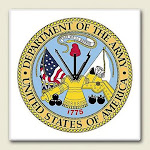My co-blogger, Kathy, at Liberty Street has asked me a question about U.S. Army unit hierarchy. I cannot answer her. Can anyone here shine some light on this ? ?
"I've just begun reading David Halberstam's book on the Korean War, and in the front matter of the book he has a listing of military terminology, of military units, from largest to smallest: Army, Corps, Division, Regiment, Battalion, Company, Platoon, and Squad. He says:
An Army is comprised of 2 or more Corps and is normally commanded by a full General.
A Corps is comprised of 2 or more Divisions and is normally commanded by a Lieutenant General.
A Division is comprised of 3 Regiments and is commanded by a Major General.
A Regiment is comprised of 3 Battalions and is commanded by a Colonel.
A Battalion is comprised of 4 or more Companies and is commanded by a Lieutenant Colonel.
A Company is comprised of 4 Platoons and is commanded by a Captain.
A Platoon is comprised of 4 Squads and is commanded by a Lieutenant.
A Squad has 10 or more soldiers in it and is commanded by a Staff Sergeant.
Does the above accord with your experience of military hierarchy?"
Subscribe to:
Post Comments (Atom)







2 comments:
Been a long time Chief, and I was a Jarhead, spadoman could probably do a better job, but yes, that's pretty much it.
d.
That is indeed the way it is suppose to be. There are exceptions everywhere, especially in a war zone. Even in peacetime or in units at a base in the States, therev are differences in numbers and in the rank of the people in charge.
For example, I was an E-5 sergeant and led a squad. Our squad didn't have ten men, just not enough soldiers to make up a complete squad, and in the case of leadership, no one was a staff sergeant, so I was given command as most senior sergeant, one step below a staff sergeant.
These guidelines are the way it is written, but the reality of how many people are readily available makes the exceptions.
Post a Comment